
geralt / Pixabay
This just in . . . your future customers are researching the products they want to buy online. And when they do those searches, they do them by typing keywords into Amazon. So why aren’t you doing Amazon keyword research?
In fact, according to research done in the past by Jumpshot (prior to the company ceasing operations in early 2020), your future customers have been searching for products on Amazon MORE than they have searched for them in Google since 2015.
Need more proof? Consider:
- Nearly 47% of US internet users started product searches on Amazon, compared to 35% who went to Google first. Source: Adeptmind
- 41% of US digital shoppers searched and purchased only on Amazon, versus 28% who searched on Google and then bought on Amazon. Source: Salsify
So, if the majority of your future customers are using Amazon for their product searching and, ultimately, also their product purchasing . . .
Do you have a strategy for maximizing your SEO on Amazon?
Stop muttering ‘no’ under your breath. Below are five ways to approach your Amazon keyword research.
A Quick Note Before Reviewing Amazon Keyword Research Strategies
It would be shortsighted of me to not acknowledge that there are several free and premium Amazon keyword research tools out there.
- AMZTracker
- AMZScout
- KeywordTool.io
- MerchantWords
- Scientific Seller
- Sonar
The strategies outlined below are not intended to replace tools like those. Instead, these five alternatives (but still effective) to approaching Amazon keyword research for your SEO campaigns are offered to help you avoid:
- Taking on additional expenses for another one-use software
- Giving up your contact info to an agency that has created a limited freemium tool
- Focusing solely on Amazon SEO when your goals for organic search extend beyond one platform
Amazon Autocomplete: Experiment With Amazon’s Suggested Searches
Difficulty to Complete: Low (a built-in feature of Amazon search)
Effectiveness for Keyword Research: High
This might sound like a no-brainer, and it kind of is. Just as Google has an autocomplete or autosuggest feature in its search bar, so does Amazon.
It’s been a feature of Amazon’s search box for years.
It’s also a keyword research goldmine.
Now, before you go all in and hitch your wagon to mining Amazon autocomplete, make the time you invest as fruitful as possible by adding an extension to your Chrome or Firefox browser called Keywords Everywhere.
Don’t know about Keywords Everywhere? It’s a premium browser extension that shows search volume, CPC stats, and competition data in almost every keyword research tool that doesn’t already give you data!
Installation is straightforward. But below is a screenshot of the extension settings if you want to make sure keyword search volumes are turned on in the Amazon autocomplete search box.
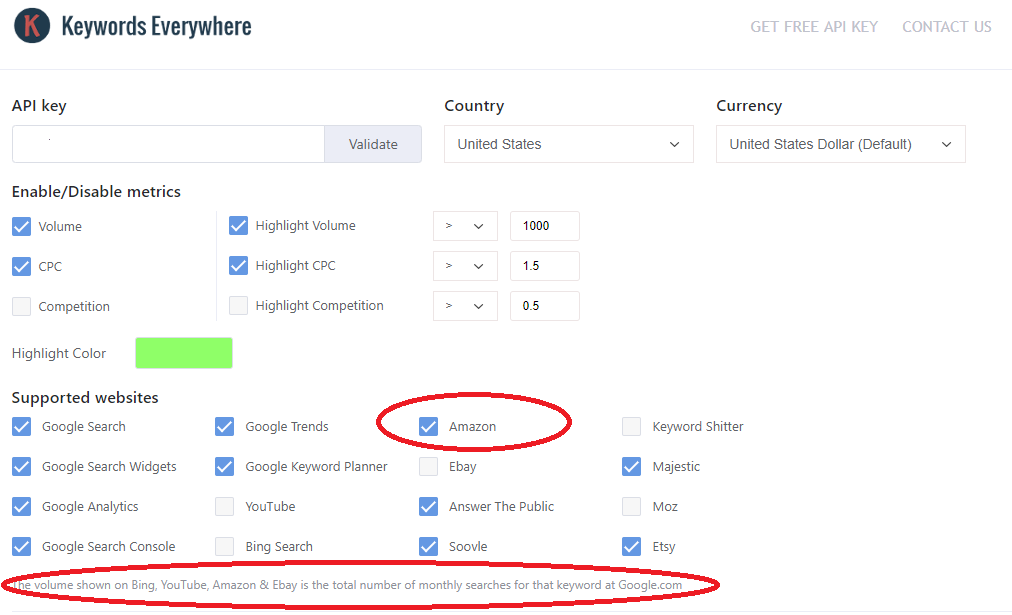
Once you turn those settings on, refresh your browser page with the Amazon homepage. Once it loads, you should see monthly keyword searches, CPC stats, and competition data next to each suggested keyword.
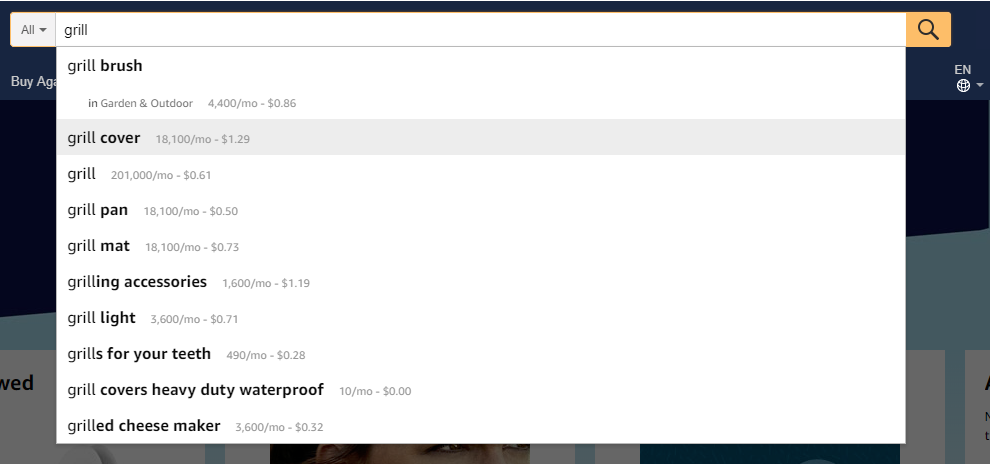
Voila! Research away trusted Amazon campaign strategist!
Now, keep in mind that all of the search volumes, CPC, and competition numbers are based on Google search. Instead of solely depending on these metrics, you are better off using them simply as an indicator of popularity and priority.
After all, wouldn’t you rather have free, imperfect metrics than no metrics whatsoever?
Soovle: Source Keywords From 15 Search Engines
Difficulty to Complete: Low (the tool is free to use)
Effectiveness for Keyword Research: High
Another highly effective, but seldom featured, free keyword tool for Amazon keyword research is Soovle.
If you are a veteran SEO, then Soovle probably isn’t new to you. It’s been on the web since October 2008. For those not in the know, Soovle is a customizable search engine that provides autocomplete and autosuggest ideas from more than 15 engines from around the globe.
To get the most benefit out of Soovle, optimize the search engines you use to give you data from as many eCommerce platforms as possible. Consider giving the following a try (alphabetical order):
- AliExpress
- Amazon
- Bing
- eBay
- Overstock
- Rakuten
- Walmart
- Yahoo!
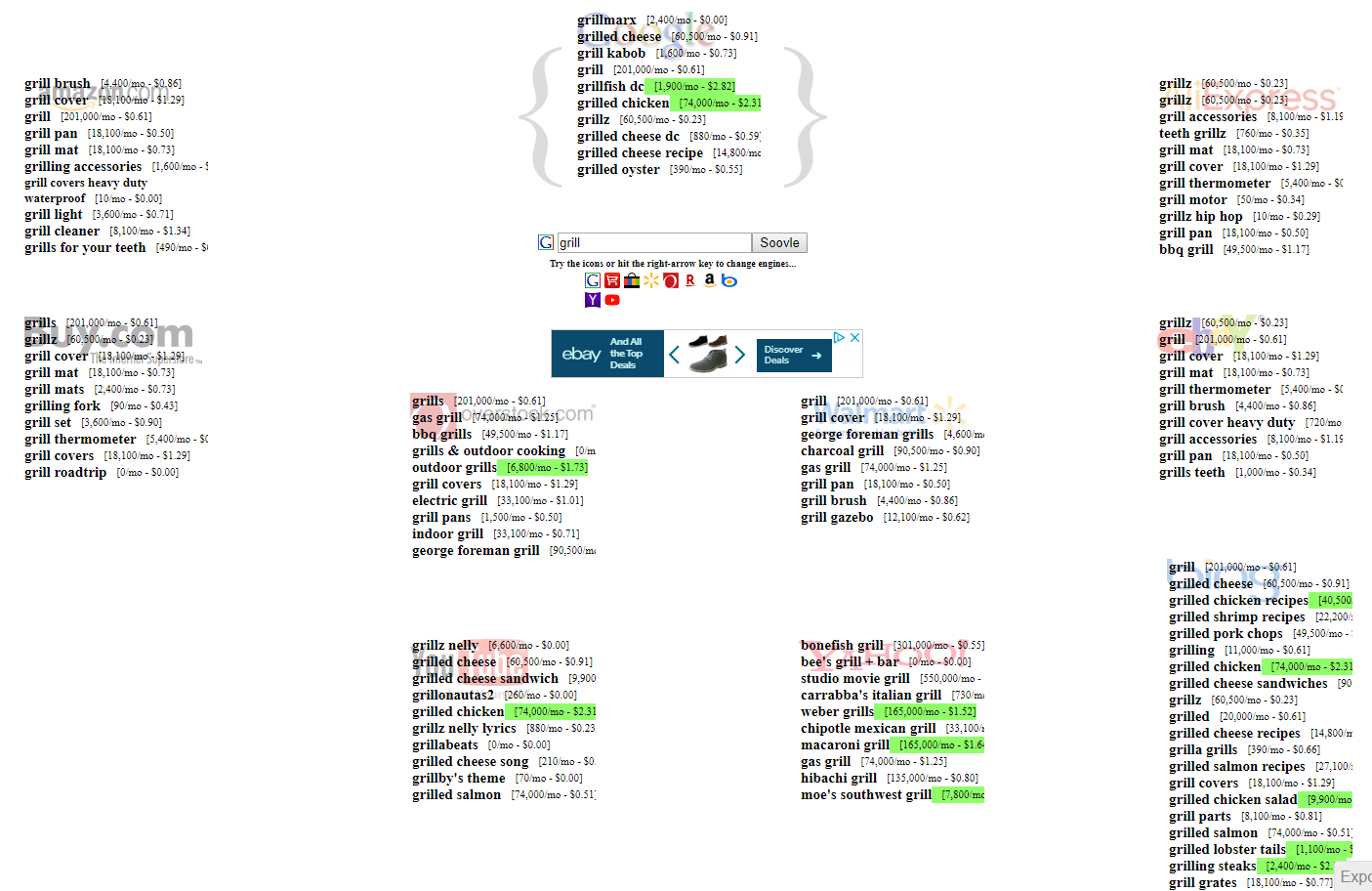
Once again, voila! Research away trusted Amazon campaign strategist!
Collect all of the unique phrases that are relevant to your products from Soovle, and then add them to your Amazon SEO keyword strategy.
Oh, and before you move on, here’s a bonus tip if you’re going to use Soovle . . . data from Keywords Everywhere is compatible with Soovle in Chrome and Firefox.
Competitor Analysis: Mine The Metadata Of Their Top Amazon Listings
Difficulty To Complete: Medium (need to be able to read source code)
Effectiveness For Keyword Research: Low (this is a useless SEO field, and Amazon doesn’t invest much effort into it)
According to research in 2018 from Hitwise, searchers on Amazon are more likely to do . . .
- Product-specific searches
- Singular keyword phrase searches
. . . than searchers on Google are likely to do.
To tap into this behavioral difference of Amazon searchers, consider mining metadata of keywords for the products that you compete against. This is especially important for products that are aftermarket versions of, alternatives to, challengers of, or complementary to a market leader.
You can find the meta keyword information for your competing products by viewing the source code of the product listing. Below is a quick run-through on how to view the page source code (for those who are unsure how to do so).
- Load the webpage that you want to view in your browser
- Right-click (CTRL + click on a Mac) and select “View Source” or press one of the following keyboard shortcuts
- Ctrl + U in Chrome, Firefox, and IE/Edge
- Ctrl + Option + U in Safari
Once you pull up your source code in your browser, do a keyword find (Ctrl + F) for the word keywords. Typing this into your find search box should lead you to a line of code that looks like the following.

Voila! You now have Amazon-selected keyword ideas from your top competition.
Copy and paste those keyword phrases out of that line of code and into a document. Once you have finished that, repeat the process for the remaining products you want to review.
Voila! You can now incorporate your competitors’ keywords into your Amazon SEO strategy.
Keyword Gap Analysis: Your Domain vs. Amazon
Difficulty to Complete: High (requires a premium SEO tool account or an incredible amount of patience)
Effectiveness for Keyword Research: Medium-High (more Google-based research than Amazon)
One of the easiest ways to get keyword ideas for Amazon is to see what keyword rankings their site shares in common with your site.
To discover this, you need to benchmark your site against Amazon by completing a keyword gap analysis.
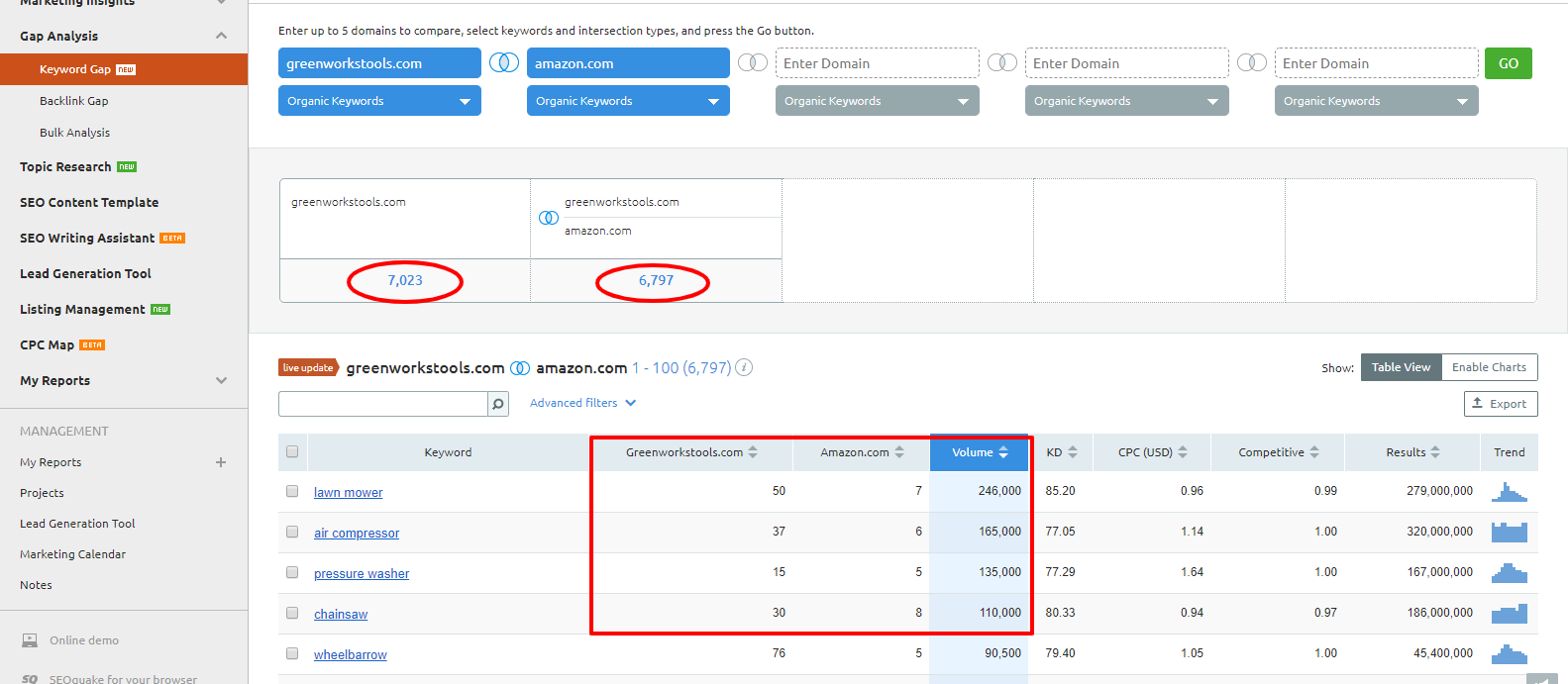
Voila! You now have a snapshot of how Amazon’s SEO strategies overlap with your own.
In this gap analysis, you compare your domain against Amazon to discover what phrases your sites have in common, and how many ranking positions separate you.
You can also leverage this analysis for Amazon PPC campaigns if you plan on running multiple campaigns on their platform that are keyword-centric.
Once you compile this information, benchmark how many keywords your domain and Amazon have in common. Then use those keywords in your campaign strategy.
At DOM, we use a proprietary procedure for this that leverages a combination of premium tools. Check out this free tool from The HOTH if you want to see some results of your own.
Note that this can be done manually, but it is incredibly tedious. You’d also have to operate under the assumption that you know the keywords that your potential customers use to search for your products, both on Amazon and Google.
Because you are reading this post, it is safe to assume you are a smart marketer :)? (a good-looking one, too!). You might know a few of the important keywords for your product, but chances are also really good that you don’t know them all.
Use a data-mining tool if at all possible.
Amazon Quick View: Keyword Ideas “Uncover When You Hover”
Difficulty to Complete: Low (Chrome extension)
Effectiveness for Keyword Research: Medium (easy to view competitors, hard to get search volume)
Now, before you go all “Whoa! This is from one of those Amazon keyword tools.” three things . . .
- You’re right
- You need to register an account with the developer to use it
- It’s free to use for about a 48-hour trial
I looked into numerous free-to-use research tools for Amazon keywords before settling on Amazon Quick View as a recommendation.
Here’s what it is and how it works.
Amazon Quick View is a Chrome extension from AMZScout, an Amazon product research SaaS company based out of Philadelphia.
With Quick View, you can quickly access crucial data about each product on an Amazon search results page.
For keyword research, the real value Quick View provides comes when you hover over a product image to pull up data in the (ahem) quick view.
When you do, click the third tab titled “Keywords” and prepare to be amazed!
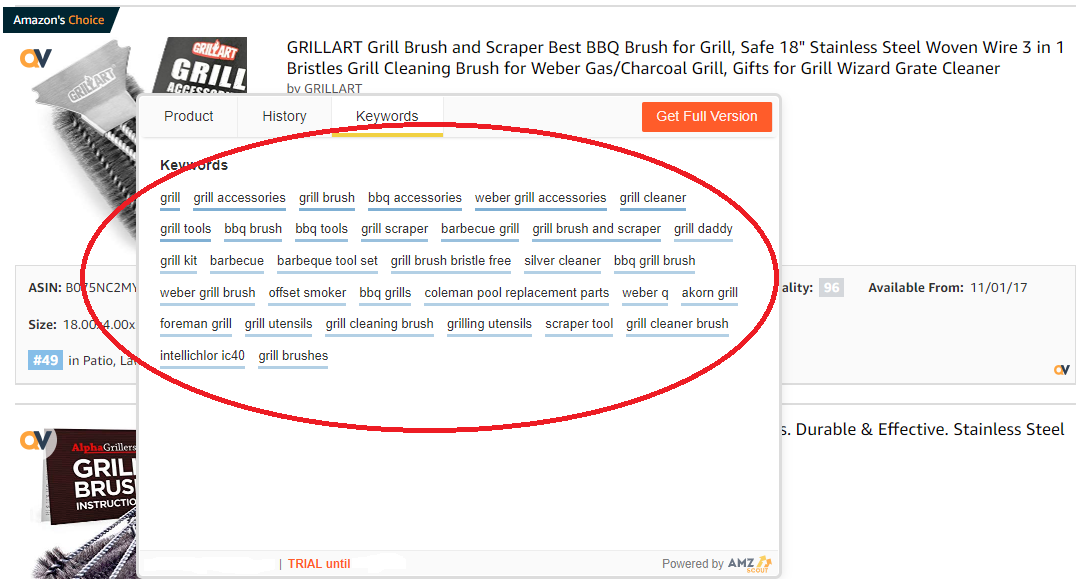
Voila! You now have dozens of keyword ideas at your fingertips.
Leveraging the free version of this tool alone, without purchasing the premium version, does come with some limitations:
- You need to act quickly after you install and register
- You do not get search volume estimates for the keywords
But, on the plus side, you will get the following:
- Keyword ideas straight from the products you compete against
- Product sales margin %
- Product listing quality
- Product rankings by category
Oh, and keep in mind that you get all of that information for any product you want to review.
Wait to sign up until you are really ready to dive in. But once you do, install, register with AMZScout, and go crazy with keyword research and other product positioning ideas through Amazon Quick View.
Your Future Customers Are Already On Amazon.
What Are You Waiting For?
There’s no need to go with your gut or rely on just an opinion any longer. The research speaks for itself.
Digital shoppers are skipping the search engine more and more in today’s on-demand marketplace. Instead, they are starting and completing the entire buyer’s journey on one platform: Amazon.
Whether you are selling digital or physical products, understanding how consumers search for what you sell on this platform is crucial to growing your business online.
In order to do that, you need to do Amazon keyword research.
But just because you need to do it doesn’t mean you also need to invest hundreds or thousands of dollars per year in a new software suite.
Rather, if this is your first foray into selling on Amazon, why not save the expense until you have some success? Install a free browser extension like Keywords Everywhere, and then try one of the five Amazon keyword research strategies that were covered above:
- Experiment with Amazon’s autocomplete
- Source ideas from 15+ search engines using Soovle
- Mine the metadata of keywords from the product listings you compete against
- Run a gap analysis of your domain against Amazon.com
- Install Amazon Quick View in Chrome and get keyword ideas plus serious product intel
Using these strategies, you should be able to confidently create a plan of action to take your products onto the Amazon platform. Fulfill your proof of concept, create a new sales channel for your product, get your “five-star rating” in the next board meeting . . .
And then consider investing in a SaaS platform for data-driven Amazon marketing or leverage Amazon Ads to figure out which keywords drive sales.
Do these approaches to Amazon keyword research feel like they might be too much of an undertaking for you or your team? No need to worry.
This article was originally published on the digital marketing blog from Direct Online Marketing.
Digital & Social Articles on Business 2 Community
(69)
Report Post








